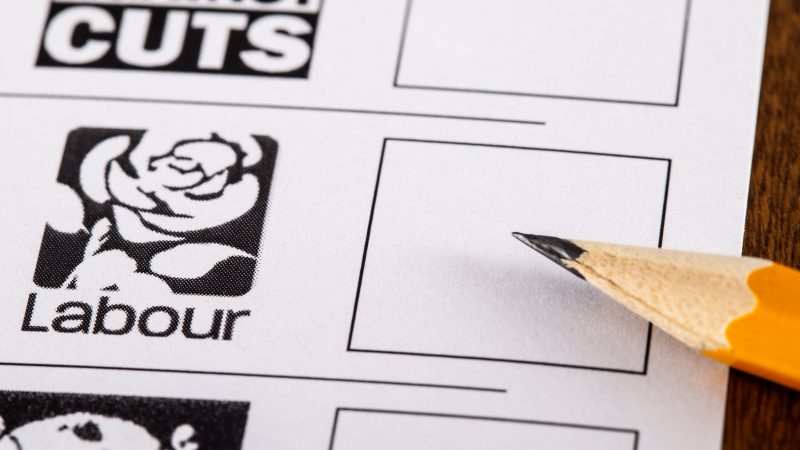
Last month, I set out my annual benchmarks for the May elections. How did Labour do against the various measures? There are four main ways of measuring Labour’s national performance: national projected vote share, raw number of councillors, number of councillors gained or lost and number of councils controlled.
On national vote share – a projected figure calculated by the BBC as though the entire country had been voting – Labour scored 35%. This is down one percentage point from 2018, when the seats being fought on May 5th in England were last contested, but up six points compared to last May and the second highest score in the last decade. Compared to the 2019 general election, Labour is up three percentage points and the Tories are down 12, from 42% to 30% – a Conservative to Labour swing of 7.5 points. A year ago, the Tories were still seven points ahead. Labour’s five-point lead over the Conservatives is the highest since 2012.
The raw number of Labour councillors (including the thousands who were not up for election on Thursday) is now, by my calculation, 5,904. This remains at a historically low level (we had more than 7,000 councillors in 2014) but is at least heading upwards again.
Labour gained a net 108 councillors across England, Scotland and Wales. This is the highest number of net gains since 2014. The small net gain in England (+22) comes on top of continuous previous gains in this cycle of seats in 2010 (+372), 2014 (+246) and 2018 (+79), which left very little still to take this year.
Labour also gained a net six councils, taking control of 12 (Barnet, Blaenau Gwent, Bridgend, Crawley, Cumberland, Kirklees, Rossendale, Southampton, Wandsworth, West Dunbartonshire, Westminster and Worthing) and losing control of six (Croydon, Harrow, Hastings, Hull, Neath Port Talbot and Tower Hamlets). This increases the number of councils we control to 97, but this remains a low number – we controlled 120 councils in 2014, for instance. Key defensive battles were also won in Bury and Sunderland, both of which were heavily targeted by the Tories.
The party has highlighted a number of key parliamentary marginals where the vote share in this election clearly indicates Labour would gain the parliamentary seat. These included Carlisle, Copeland, Great Grimsby, Hartlepool, Ipswich, Leigh, Lincoln, Peterborough, Stevenage, Thurrock, West Bromwich East, West Bromwich West, Wolverhampton North East, Wolverhampton South West, Worcester and Workington. Progress in terms of seat gains was also made in Colchester, Derby, Swindon and Wrexham.
The results in Scotland saw Labour move into a clear second place in national vote share and number of councillors, which is crucial for attracting anti-SNP tactical voting, and the detailed results put a number of SNP vs Labour marginal seats in the central belt back in play for the next general election. Gaining absolute control of West Dunbartonshire was a particularly good achievement as majority control of a council is extremely difficult to achieve under Scotland’s proportional single transferable vote (STV) voting system.
The location of the council gains showed a pleasing range across the nations and regions of the UK. We gained councils in every part of the country. Cumberland, Rossendale and Kirklees in the ‘Red Wall’ North. Worthing, Crawley and Southampton in the south (an interesting mix of two traditional marginal areas and Worthing which until recently was a safely Tory area). Barnet, Westminster and Wandsworth in London, targets that have been perpetually talked up for decades but never won. Bridgend and Blaenau Gwent in Wales. West Dunbartonshire and moving into a clear second place in Scotland.
This exceeded what was thought possible given the seats in England were last fought in 2018 and were mainly Labour-held anyway, so the scope for gains was limited. There are, however, still areas of the country where the organisational, reputational and political damage of the Jeremy Corbyn years has not yet been fully repaired. For instance, the areas where results were not satisfactory, where these coincide with key marginal seats, give us a clear indication of where the new trainee professional organisers the party is recruiting need to be deployed.
As an national executive committee member, I can say we are acutely aware of how much still needs to be done to get Labour ready to win everywhere but pleased with the obvious progress that has been made.




More from LabourList
Lord Hayward: Disappointing May elections could decide Keir Starmer’s fate
LabourList Christmas quiz 2025 round 5: factions and unions picture round
LabourList Christmas quiz 2025 round 4: Christmas Connects